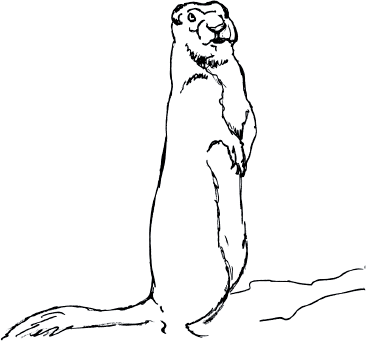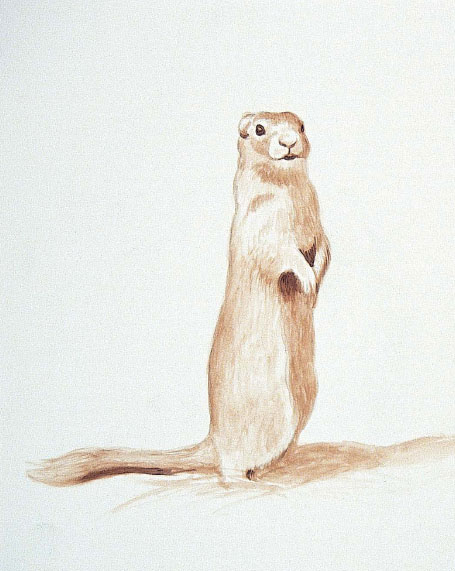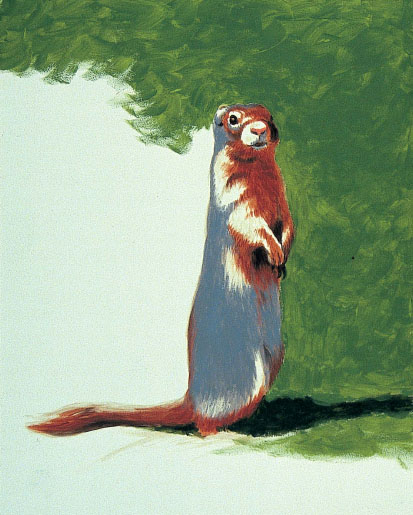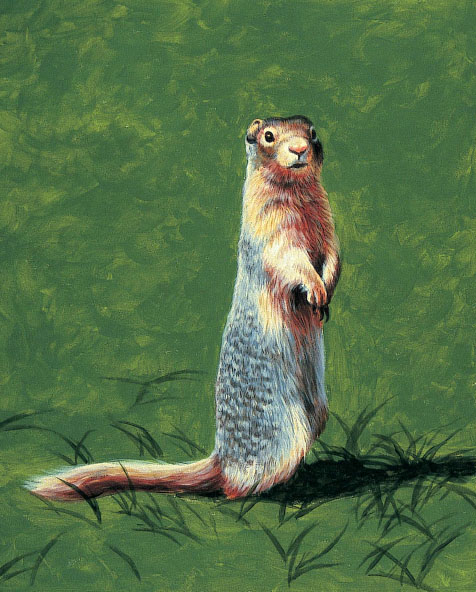Project 32: Columbian Ground Squirrel
On a family trip to Banff National Park in Alberta, Canada, one of our most enjoyable experiences was meeting the Columbian ground squirrels. In one area, the squirrels were so trusting and accustomed to being fed peanuts, that if you sat down on the ground very still, they would climb onto your lap!


Reference Photo
Materials
Paints
Burnt Sienna
Burnt Umber
Cadmium Orange
Cadmium Red Medium
Hansa Yellow Light
Hooker’s Green Permanent
Raw Sienna
Titanium White
Ultramarine Blue
Brushes
no. 3 and 10 round
no. 10 bright

1 Establish the Form
Draw the squirrel lightly in pencil, using a kneaded eraser to lighten lines or make corrections. With Burnt Umber thinned with water and a no. 10 round, paint the basic lines and shadows. For the shadows on the squirrel, mix dark brown with Burnt Umber and Ultramarine Blue. Paint with a no. 10 round.

2 Paint the Dark Values
Continue painting the dark areas of the squirrel with dark brown. Mix dark green for the squirrel’s ground shadow with Hooker’s Green Permanent, Cadmium Orange, Burnt Umber and Ultramarine Blue. Paint with a no. 10 round.

3 Paint the Middle Values and Begin Painting the Background
Mix a light rufous color for the squirrel’s coat with Burnt Sienna, Cadmium Orange and Titanium White. Paint short, parallel strokes in the direction of fur growth with a no. 10 round.
Mix blue-gray for the squirrel’s belly, back and head with Titanium White, Ultramarine Blue and a small amount of Burnt Umber. Paint with a no. 10 round.
Mix pink for the nose with Titanium White, Cadmium Red Medium, Burnt Sienna and Cadmium Orange. Paint with a no. 10 round.
Mix a field green background color with Hooker’s Green Permanent, Cadmium Orange, Titanium White and Raw Sienna. Paint with a no. 10 bright, using dabbing strokes. Switch to a no. 10 round to paint around the squirrel’s outline.

4 Finish the Background Color and Paint the Light Values
Finish painting the background using the field green. Mix a highlight color for the squirrel with Titanium White and small amounts of Raw Sienna and Hansa Yellow Light. Using a no. 10 round, paint parallel strokes that follow the fur pattern. Paint the mottled checkerboard pattern on the back over the blue-gray with small, parallel strokes. Overlap where the highlight meets the adjacent color with thin strokes of the highlight color. Vary the length of the strokes—longer on the body and shorter on the head and paws.
Tip
Create an impression of light and depth in the background by varying the amount of paint used on the panel. Allow it to show through more in some areas than in others.

5 Paint the Detail
Paint dark detail on the squirrel’s back with dark brown and a no. 10 round, using short strokes. Soften and blend with a separate no. 10 round and blue-gray. Add dark fur detail to the belly and chest with longer strokes, softening with the adjacent color. Add detail to the highlighted areas with the rufous, using fine strokes and a small amount of paint.
Begin to paint dark blades of grass with the dark green shadow color and a no. 10 round.
Tip
To make the squirrel’s fur stand out against the background, transfer a portion of the highlight color to a dry palette. As the paint dries, it will become thicker and more opaque. Paint the edges of the highlighted side of the squirrel with a no. 10 round. If the paint becomes too dry, use a spray bottle to moisten it.
To make the shadowed side of the squirrel stand out, use some blue-gray mixed with Titanium White. For the chest, use light rufous mixed with Titanium White.

THE SENTRY
Acrylic on Gessobord
10” × 8” (25cm × 20cm)
6 Paint the Finishing Detail
On a dry palette, create the light blue fur softening color with a portion of blue-gray and some of the highlight color. With a no. 3 round, paint thin strokes over the mottled pattern on the back to soften it. Reinforce the outline of the back with the highlight color. Add some of the rufous to the back with a no. 3 round, using thin strokes.
Mix a highlight color for the eye with Titanium White and a bit of blue-gray. Use separate no. 3 rounds to paint the highlight, blending with dark brown. Reinforce the highlight with a touch of pure Titanium White.
Mix a whisker color with some dark brown and blue-gray. Paint thin, light strokes with a no. 3 round. Tone down the whiskers with the adjacent color if they come out too dark.
Paint more blades of grass with dark green and a no. 10 round. Make the strokes smaller and lighter and use less paint as you work into the background behind the squirrel. Tone down any blades that stand out too much with the field green color. Paint some blades with rufous to give the grass a more natural look.
